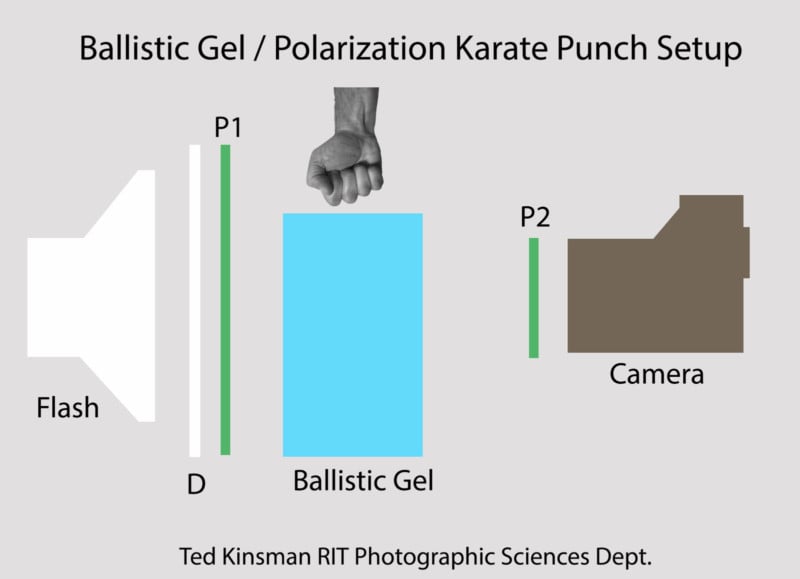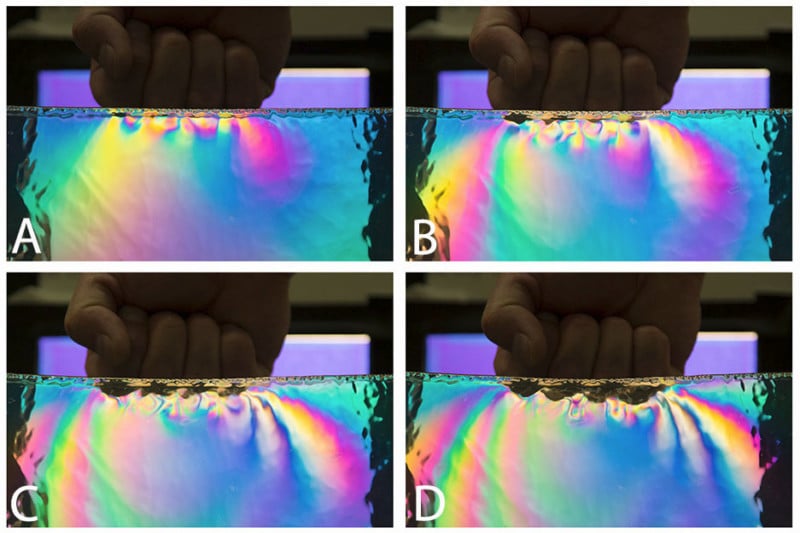How to Photograph the Power of a Punch Using Polarized Light
![]()
Many materials show internal stress when illuminated with polarized light and photographed with a second analyzing polarizer. This unique property of materials is called birefringence. Some of the more common material that exhibits this property is glass, ice, and most plastics.

Equipment setup. D is a diffuser, P1 is the first polarizing sheet, P2 is the analyzing polarizer and on the far right is the camera.
To photograph the ballistic gel, the block was illumined by an Einstein flash operating at 1/64th power. There is a sheet of plastic tracing paper placed on the flash side of the polarizing film that acts as a diffuser. The block of ballistics gel is smoothed with a heat gun to make it optically clear. A second polarizer is placed over the lens of the camera to be the analyzing polarizer. Without the analyzer on the camera, you would not be able to observe the birefringence can. I like to think of these systems as a polarizing sandwich where the meat is the object showing the stress, while the bread represents the polarizers.

To record the high-speed action, I used a Mumford time machine to trigger the flash at exactly the correct time. A microphone taped to the ballistic gel detected the punch. The system worked surprisingly well and I was able to see the unique stress patterns in the ballistic gel produced by of different punches.
Special thanks to Aric Keyes of Kime Karate who systemically hit the block of ballistic gel time and time again.
Here’s a professional karate punch performed by Aric Keyes:
![]()
Note the even distribution of force through the block of ballistic gel that simulated human tissue.
Here’s a professional karate knuckle punch performed by Aric Keyes:
![]()
Note the distribution of force is much different from the punch shown above.
Here’s an example of a punch performed by an untrained individual:
![]()
The uneven angle of the knuckles shows the uneven pressure in the contact area. The use of ballistic gel is an excellent technique for visualizing proper punching technique.
A head butt performed by me:
![]()
This type of defensive blow is known for doing equal damage to each of the participants.
Finally, here’s a high-speed video recorded with an Edgertronic high-speed video camera:
Sources: Clear Ballistics Gel, Polarizing Sheet Rosco Polarizing #7300 Filter – 17×20″ Sheet, Einstein Flash E640, Mumford Time-Machine Camera Controller.
About the author: Ted Kinsman is an assistant professor of photographic technology at the Rochester Institute of Technology. He teaches advanced photographic technology, light microscopy, and macro photography courses. Kinsman specializes in applying physics to photography. You can find more about him and his work in his faculty profile and on his website.